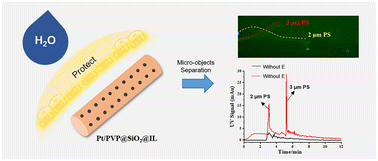Fabrication of ionic liquid-mesoporous silica/platinum electrode with high hydroelectric stability for electric-field-assisted particle separation
Abstract
Surface chemistry of electrodes plays a critical role in the fields of electrochemistry and electric-field-assisted separation. In this study, making ingenious use of the ordered mesoporous structure of silica materials and the electrochemical stability of ionic liquids (ILs) when integrated with polyvinylpyrrolidone (PVP), the PVP-modified IL-mesoporous silica/platinum wire (Pt/PVP@meso-SiO2@IL) was fabricated to increase hydroelectric stability and avoid the problem of electrode polarization. The effect of different amounts of mesoporous silica material used to modify the surface of the Pt electrode was systematically investigated. As a result, we successfully obtained a highly ordered mesoporous Pt/PVP@meso-SiO2 material with smooth surface. Because pentyl triethylamine bis(trifluoromethylsulfonyl) imide exhibits a wide electrochemical window between −3 to 3 V, this IL was chosen to modify mesopores under vacuum. Even after repeatedly applying electric field on Pt/PVP@meso-SiO2@IL 100 times, this working electrode remained stable and showed high hydroelectric stability. After verifying the feasibility of this method, it was successfully applied in the electric-field-assisted separation of 2.0 and 3.0 μm polystyrene particles without any impediment from electrode polarization problems. This work provides a brand-new insight for resolving the problem of electrode polarization by developing a versatile tool for the electroseparation of micro-objects.



 Please wait while we load your content...
Please wait while we load your content...